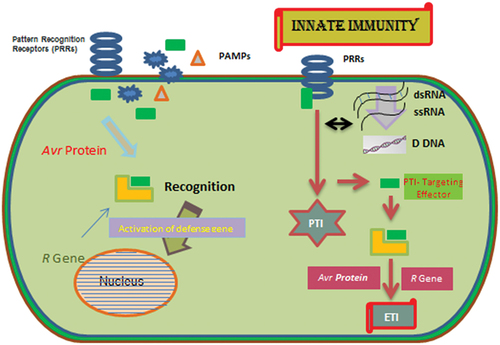Figures & data
Figure 1. Genome of begomovirus is bipartite or monopartite. The gnome of begomovirus depends on the presence of 1 or 2 components (DNA-A & DNA-B). The virion sense strand of DNA-A encodes pre-coat and coat proteins. The complementary sense strand of DNA-A encodes Rep (Replication associated proteins), TAP (Transcriptional activator protein), REP (Replication enhancer protein) including C4 protein. It is detected that DNA-B encodes NSP (Nuclear shuttle protein) and MP (Movement protein) on the virion sense strand and complementary sense strand respectively.

Figure 3. Attack of pathogen cause the production of various signaling molecules which plays their significant role in defense. Pathogen produces MAMPs and PAMPs to invade, in response plant produce PRRs (Pattern Recognition Receptors). At this point recognition takes place, (if the Avr protein fits in R gene, means no infection otherwise vice versa). After recognition, plant produces various types of chemical compounds (Phytoalexins, PR Proteins, AMPs, SA (Thianin), Plant defensins) to kill pathogen. This first line of defense is known Pathogen Triggered Immunity (PTI). After first line of defense, pathogen defeated so it send signals to nucleus to produce most powerful Avr gene which give rise to the production of effectors/elicitors. In response of pathogen’s elicitors, plant produces receptors. After recognition, plant produce different defense related enzymes like SA. SA spread to the whole plant and develop SAR (Systemic Acquired Resistance). This is known as (ETI) Effector Triggered Immunity.

Table 1. Biocontrol agents against CLCuV and whitefly along with their secretions and mode of action.
Table 2. Phytoextracts along with their active ingredient and mode of action toward CLCuD.

